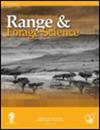Nutritional quality of Calobota sericea fodders harvested at different phenological stages – opportunities for inclusion in fodder flow programs for extensive livestock farmers
IF 1.9
4区 环境科学与生态学
Q3 ECOLOGY
引用次数: 4
Abstract
Calobota sericea (Thunb.) Boatwr. & B.-E.van Wyk (Fabaceae) is a native legume from the semi-arid rangelands of South Africa. The species has been prioritised as a forage for water-limited agro-ecological areas. No information regarding the nutritional quality of C. sericea forage harvested at different phenological stages is currently available, limiting our knowledge as to the best time to harvest the forage. The aim of this study was to determine the nutritional quality of C. sericea forage harvested at five phenological stages. Results from the study show that crude protein, fibre, energy and digestibility of the forage decreased with plant maturity, but not all mineral nutrients showed the same trend. In general, C. sericea forage harvested at non-reproductive, early flower bud and full flower stages could provide sufficient energy and protein to maintain livestock condition. At these stages, the neutral detergent fibre and digestibility of the harvested materials are also good, indicating that intake and processing of these forage would not be a problem for the livestock. At these phenological stages most of the mineral nutrients were also sufficiently high to meet the minimum requirements of small stock. Thus, C. sericea forage harvested at the appropriate phenological stages could provide a useful source of forage for resource poor farmers.在不同物候阶段收获的卡洛布塔(Calobota sericea)饲料的营养质量——为广大畜牧农民提供纳入饲料流动计划的机会
Calobota sericea(西班牙语)Boatwr。& B.-E。van Wyk(豆科)是一种来自南非半干旱草原的本地豆科植物。该物种已被优先考虑作为水资源有限的农业生态区的饲料。目前还没有关于不同物候阶段蚕蛹牧草营养质量的资料,限制了我们对牧草最佳采收时间的了解。本研究的目的是确定在五个物候阶段收获的蚕蛹饲料的营养品质。结果表明,随着植株成熟,粗蛋白质、纤维、能量和消化率均呈下降趋势,但并非所有矿质营养素均呈下降趋势。一般而言,在非繁殖期、花蕾早期和花期均可收获蚕丝草饲料,以提供足够的能量和蛋白质维持牲畜状态。在这些阶段,收获的原料的中性洗涤纤维和消化率也很好,表明这些饲料的摄入和加工不会成为牲畜的问题。在这些物候阶段,大多数矿质养分也足够高,足以满足小种群的最低需要。因此,在适当的物候阶段收获蚕蛹牧草可以为资源贫乏的农民提供有用的饲料来源。
本文章由计算机程序翻译,如有差异,请以英文原文为准。
求助全文
约1分钟内获得全文
求助全文
来源期刊

African Journal of Range & Forage Science
ECOLOGY-ENVIRONMENTAL SCIENCES
CiteScore
4.00
自引率
14.30%
发文量
35
审稿时长
>12 weeks
期刊介绍:
The African Journal of Range & Forage Science is the leading rangeland and pastoral journal in Africa. The Journal is dedicated to publishing quality original material that advances rangeland ecology and pasture management. The journal aims to publish research of international importance from any region, but as an African journal, we are particularly interested in research from Africa and relevant to the continent. The Journal promotes both science and its application and authors are encouraged to explicitly identify the practical implications of their work. Peer-reviewed research papers and research notes deal primarily with all aspects of rangeland and pasture ecology and management, including the ecophysiology and biogeochemistry of rangelands and pastures, terrestrial plant–herbivore interactions (both domestic and wild), rangeland assessment and monitoring, effects of climate change on rangelands, rangeland and pasture management, rangeland rehabilitation, ecosystem services in support of production, conservation and biodiversity goals, and the identification and development of intensive and semi-intensive pasture and forage resources to meet livestock production needs. Articles highlighting transdisciplinary linkages among biophysical and social sciences that support management, policy and societal values are particularly encouraged. The Journal includes relevant book reviews and invited perspectives that contribute to the development of range and forage science. Letters to the editor that debate issues raised in the Journal are acceptable. The African Journal of Range & Forage Science is the official journal of the Grassland Society of Southern Africa.
 求助内容:
求助内容: 应助结果提醒方式:
应助结果提醒方式:


